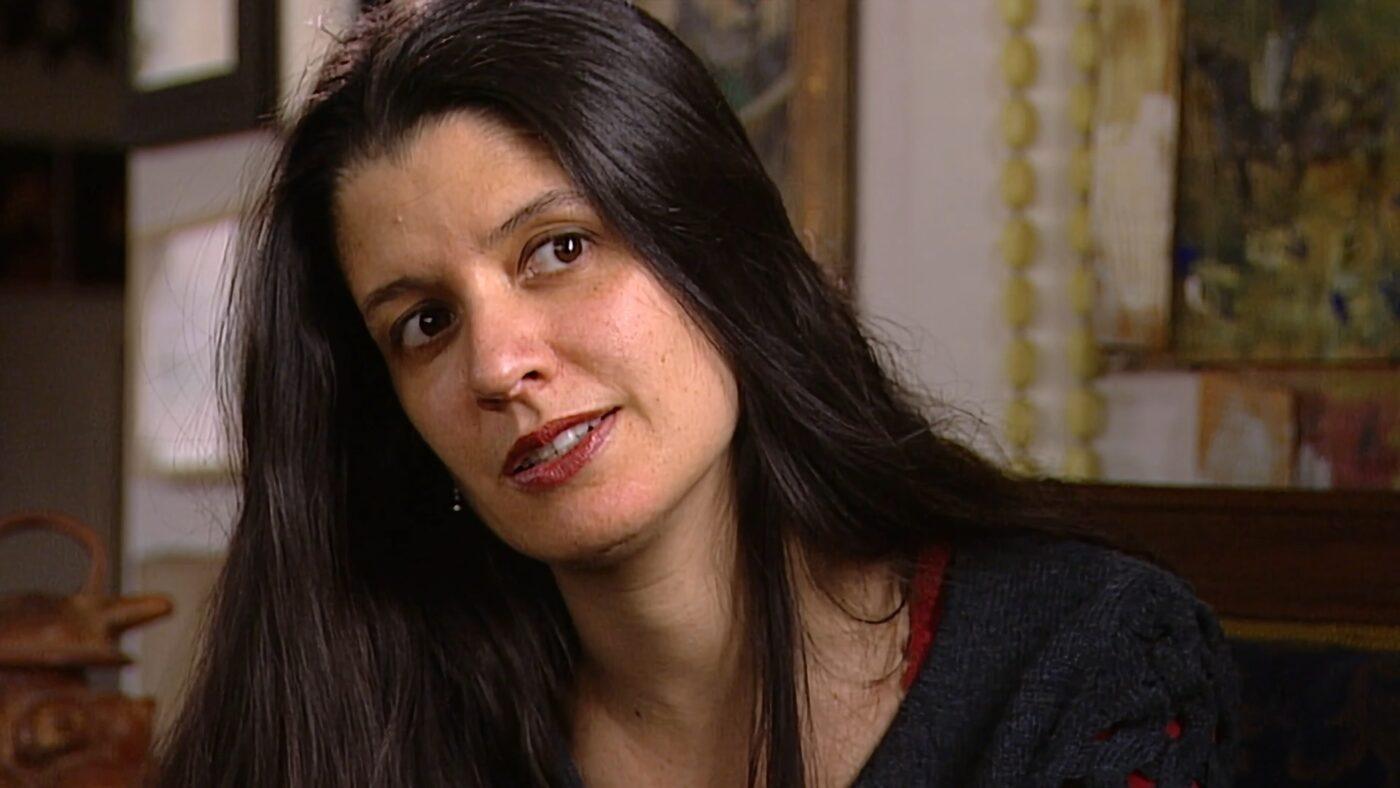Interview
“Lick and Lather”
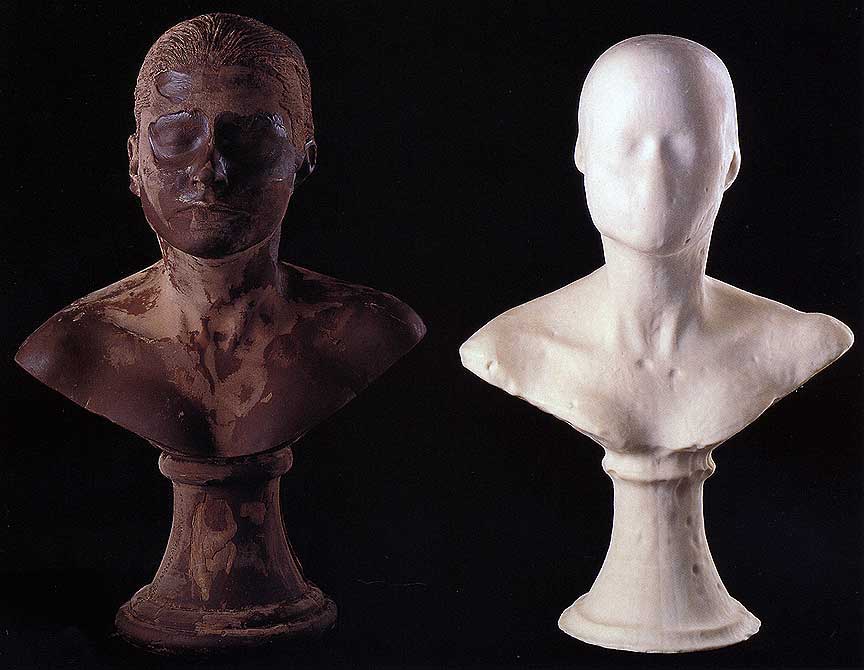
Janine Antoni. Lick and Lather, detail, 1993. 7 soap and 7 chocolate self-portrait busts; 24 x 16 x 13 inches each. Collection of Jeffrey Deitch, New York. Photo by John Bessler. Courtesy the artist and Luhring Augustine.
Janine Antoni discusses her 1993 work, “Lick and Lather.”
ART21: Let’s talk about your sculpture, Lick and Lather. How was it made?
ANTONI: I wanted to work with the tradition of self-portraiture but also the classical bust. So, the way I made it is: I took a mold directly from my body. I used a product called alginate, which is the kind of material that you might be familiar with when you go to the dentist, that sort of minty tasting stuff. It’s an incredible product because it gets every detail, every little pore. I even cast my hair. So, I started with an exact replica and then I carved the classical stand. I made a mold, melted down thirty-five pounds of chocolate, poured it into the mold. And when I took it out of the mold, I re-sculpted my image by licking the chocolate. So, you can see that I licked up the front and through the mouth up onto the nose, over the eye and back up over the ear onto the bun, and then down in the back around the neck.
I also cast myself into soap. She started as an exact replica of myself. We spent a few hours in the tub together. I slowly washed her down, and she becomes almost fetal because all her features start to be washed away. So, I was thinking about how one describes the self and feeling a little uncomfortable with my outer surface as the description of myself. And this piece very much is about trying to be on the outside of myself and have a relationship with my image. So, the process is quite loving. Of course chocolate is a highly desirable material, and to lick my self in chocolate is a kind of tender gesture. Having the soap in the tub was like having a little baby in there. But through that process, I’m slowly erasing my self. For me it really is about this kind of love-hate relationship we have with our physical appearance.
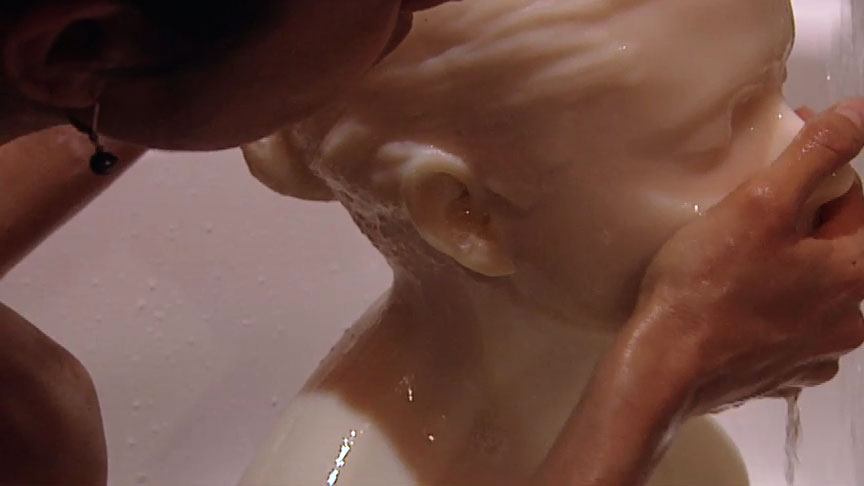
Janine Antoni creates a soap bust for Lick and Lather (1993). Production still from the Art in the Twenty-First Century Season 2 episode, Loss & Desire, 2003. © Art21, Inc. 2003.
ART21: Is it also erotic?
ANTONI: Yes, well, the thing about chocolate is that it has the product phenylamine in it. That product is the chemical that’s produced in our body when we’re in love. So, I think that’s why chocolate is so addictive.
ART21: Is there something humorous about this piece?
ANTONI: I think what’s humorous about the piece is that I’m playing with a tradition of the classical bust, which is very serious. And I asked myself some questions about why, traditionally, would artists want to make a self-portrait. And I came up with a few answers for myself.
The first one is to immortalize yourself. But, of course, my materials are ephemeral, so I’m kind of trying to work against the grain of that. And it was a funny thing because I conceived the piece to be in the Venice Biennale, and I knew that there would be classical sculpture everywhere. And I arrive in Venice and, as you probably know, Venice is totally eroding. I came upon these stone sculptures, and they looked very much like my soap head because the features had been washed away. And I thought to myself, “What does that say about our mortality, that even stone has a lifespan?”
And then the other answer I gave myself about “Why make a self-portrait?” is this idea of creating a public image of yourself, an image that you were presenting to the world. And I guess my question was: is that an accurate description of the self? And are we more ourselves alone at home eating a meal or in the bathtub, in these everyday activities? So, that’s where I got the idea to work with the chocolate and the soap.
ART21: Can you talk about the arduous quality of making the piece?
ANTONI: Yes, it took a long time to make the pieces. We spent several hours in the tub together. And I think what’s important about that is that we were very intimate with each other. And my hope is that you as a viewer can feel that intimacy. That’s what a portrait is: a way of getting close to the person that it’s depicting.
ART21: And beauty?
ANTONI: In terms of the classical bust, an issue that my work deals with a lot is the idea of woman and beauty. And thinking about how women have been depicted traditionally in sculpture and trying to take that on. There’s something quite startling about the erasure, of my process.
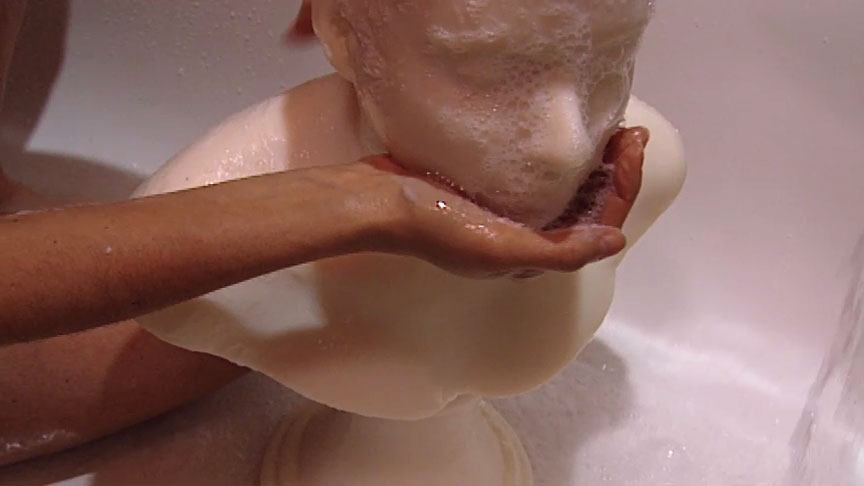
Janine Antoni creates a soap bust for Lick and Lather (1993). Production still from the Art in the Twenty-First Century Season 2 episode, Loss & Desire, 2003. © Art21, Inc. 2003.
ART21: And also, the classical bust is traditionally a man.
ANTONI: The thing about the classical bust is it’s usually reserved for depicting men, and usually very powerful men. And then, when we see women in classical sculpture, they depict hope and charity and love. I was particularly conscious of that when I made the bust and thinking about this act of erasure of this specific personality. With this particular bust here, I licked the chocolate and I licked right up the front and over the cheek. I also licked the eye and the lips and nose. And then I came around and licked, you know, over the ear and back onto the bun. And then I thought it would be nice to just lick under the nape of the neck, along up under the ear on the other side. It’s modeling, in the sense that when you carve, you start with a block and you remove from it. But what I’m doing is starting from a representation of myself and then removing from it.
ART21: What does the removal process signify for you?
ANTONI: I think it’s a funny thing when you think about the creative process and what we go through when we’re making a work. A lot of times, there’s this element of destruction, that we have to kind of unmake in order to make, and that interests me very much. And also, working from very basic materials. I’m also thinking a lot about this idea that there’s this kind of relationship between me and her, that I’m literally feeding myself with my self and washing myself with my self. So, there’s this circular narrative that’s happening.
ART21: Is there a ritualistic aspect?
ANTONI: Sure. I was thinking of everyday rituals like eating and bathing but also other rituals. Certainly the Eucharist is about eating the body, so that also comes to mind.
ART21: How do you decide to shape a bust this way and not that? Is it simply intuitive?
ANTONI: In terms of the creative process, I think that I begin with a kind of conceptual structure. That I know to lick my self in chocolate means something, or to wash with my self in soap means something. When I feel sort of comfortable with the security of a very (hopefully) rigorous conceptual structure, then I can actually let go of that kind of thinking. And when I go to wash or lick, I’m not necessarily thinking, “If I lick this area, it means one thing or another” but really trying to get intimate with the process, so a kind of surprise happens, especially with the soap bust. You know, I’m in the tub, and all of a sudden this person appears to me, and I’m not sure if she’s a relative or an alter ego, but she’s related and yet different. And there’s something so beautiful about that process, that lets her evolve through the process.

Janine Antoni creates a soap bust for Lick and Lather (1993). Production still from the Art in the Twenty-First Century Season 2 episode, Loss & Desire, 2003. © Art21, Inc. 2003.
ART21: There’s something happening in the actions you’re performing.
ANTONI: I think that because the process is so, sort of, gentle and loving, there is some kind of idea of self-love. You know, of trying to come to terms with that surface being you. I think that—and I don’t know about you, but—when I look in the mirror, I don’t really recognize myself. I somehow see myself as I was as a little girl or in other manifestations of myself. So, it’s always this contemplative moment, of trying to come to terms with what I see and how that relates to what I feel inside and trying to bring those two things together. So, I think with this whole process, you can imagine how jarring it is or how peculiar it is to lick your self. It’s like being your own lover, like putting yourself in the position of your lover and trying to understand what they’re seeing when they look at you.
ART21: Do you feel closer to the chocolate or the soap busts?
ANTONI: I really feel close to the soap bust because we spent a lot of time in the tub together. And I just sort of rub her all over and, you know, she sort of smoothes down, and then she becomes almost fetal. It’s really quite a nice process. And it’s interesting to think about cleaning and purity and just washing as a kind of ritual and its bigger meaning. I think this idea of cleaning is associated with purity.
I think I was thinking about purity in terms of woman, and that is a kind of idealized state, which of course is in contrast to the chocolate. Another way that women have been thought about is in terms of desire. So, the work is about looking at the flip side of those two states and not feeling comfortable with either.
The brown and white—really, with all my work—it comes from the material. So, I’m not so much thinking of my self in a dark color and my self in a white color. I’m thinking of my self in chocolate and my self in soap. But there is something beautiful about the way that, in her purity, she disappears.
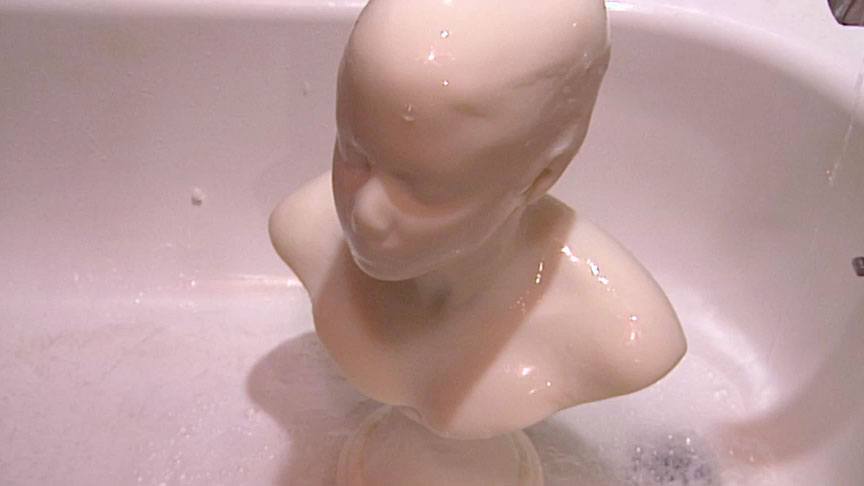
Janine Antoni creates a soap bust for Lick and Lather (1993). Production still from the Art in the Twenty-First Century Season 2 episode, Loss & Desire, 2003. © Art21, Inc. 2003.
ART21: Is there something about casting, in particular, that you enjoy? You seem to come back to that process in your work a lot.
ANTONI: I don’t know, I can think of a lot of things that aren’t done that way. Certainly you have your skills and your knowledge and you use it, and maybe there are many different ways to make an object, but you use the experience that you’ve had. So, there are certain processes that seem to come back. I was just talking to [my assistant] Melissa about this, this morning. We were moving some plywood around, and I’m like, “Why are we always making these diving boards?” Like, the way we made the rope, and then we use the same sawhorses to make the other piece. And I think we were talking about that—how there is this kind of repertoire that you come back to.
With mold making: it’s just that you look around and most of the objects around us are made that way. And because I am always trying to replicate or in some way work with everyday objects, everyday materials, I find myself there a lot. Also, I am trying to make an everyday object out of another kind of material, so casting it into that shape makes sense.
ART21: Is casting a ritual for you as well? Like transformation or transubstantiation?
ANTONI: I was saying the mold making was about imitation, like I was trying to imitate these things from the world. For me, the transformation happens somehow when I am working with the process. The process is what transforms it. Sometimes that’s in the mold making, but most of the time it’s not. Usually, at least with Lick and Lather, it’s afterwards.
This interview was originally published on PBS.org in September 2003 and was republished on Art21.org in November 2011.

